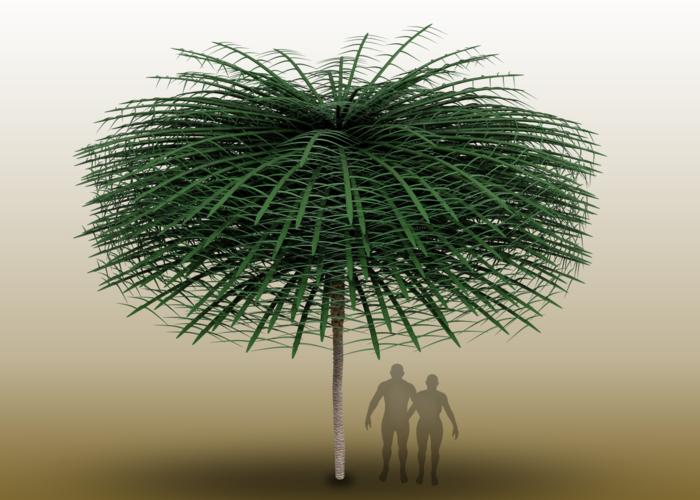In the fossil record, trees typically are preserved with only their trunks. They don’t usually include any leaves to show what their canopies and overall forms may have looked like. But now, researchers reporting in the journal Current Biology on February 2 describe fossilized trees from New Brunswick, Canada with a surprising and unique three-dimensional crown shape.

Credit: Tim Stonesifer
In the fossil record, trees typically are preserved with only their trunks. They don’t usually include any leaves to show what their canopies and overall forms may have looked like. But now, researchers reporting in the journal Current Biology on February 2 describe fossilized trees from New Brunswick, Canada with a surprising and unique three-dimensional crown shape.
“The way in which this tree produced hugely long leaves around its spindly trunk, and the sheer number over a short length of trunk, is startling,” says Robert Gastaldo of Colby College in Waterville, Maine.
The forms taken by these 350-million-year-old trees look something like a fern or palm, even though palms didn’t arise until 300 million years later, he explains. However, the functional leaves in ferns or palm trees cluster at the top and are relatively few.
“In contrast, Sanfordiacaulis preserves more than 250 leaves around its trunk, with each partially preserved leaf extending 1.75 meters from it,” Gastaldo says. “We estimate that each leaf grew at least another meter before terminating. This means that the ‘bottle brush’ had a dense canopy of leaves that extended at least 5.5 meters (or 18 feet) around a trunk that was non-woody and only 16 centimeters (or 0.5 feet) in diameter. Startling to say the least.”
This work was made possible by a long-term international collaboration with Matthew Stimson and Olivia King of the New Brunswick Museum, Saint John, and Saint Mary’s University in Halifax. The researchers’ findings offer important insights into the evolution of plants and arborescence, meaning plants that grow to a tree height, or at least 15 feet at maturity. They’re also a reminder that over the history of life on Earth, there have existed trees that look unlike any we’ve ever seen before and some that look as though they may come from the imagination of Dr. Seuss, the researchers say.
“We all have a mental concept of what a tree looks like, depending on where we live on the planet, and we have a vision of what is familiar,” Gastaldo says. “The fossil on which we report is unique and a strange growth form in the history of life. It is one of evolution’s experiments during a time when forest plants underwent biodiversification, and it is a form that seems to be short lived.
The fossils in question were preserved by earthquake-induced, catastrophic burial of trees and other vegetation along the margin of a rift lake. The first fossil tree was unearthed about 7 years ago from a quarry, but it only included one partial sample. It took several years for another four specimens of the same plant, in close spatial proximity, to also be found, Gastaldo says.
One of the specimens revealed how the leaves departed from the top of the tree, which makes it “absolutely unique.” It’s one of only a few in a fossil record spanning more than 400 million years in which a trunk is preserved around which the crown leaves are still attached, the researchers say.
“Any fossil tree with an intact crown is a rarity in the history of life,” Gastaldo says. “Having the crown leaves attached to a trunk, by itself, begs the questions what kind of plant is it, how is that plant organized, And is it some form that continues to the present, or is it outside of the ‘normal’ concept of a tree? All of these questions, and more, led to this multi-year endeavor.”
The researchers report that the tree likely relied on its unusual growth form to maximize the amount of light it could capture and reduce its competition with other plants on the ground. They suggest that the tree now represents the earliest evidence of smaller trees growing beneath a taller forest canopy. It means that plant life in the Early Carboniferous period was more complex than expected, suggesting Sanfordiacaulis lived at a time when plants were “experimenting” with a variety of possible forms or architectures.
“The history of life on land consists of plants and animals that are unlike any of those that live at the present,” Gastaldo says. “Evolutionary mechanisms operating in the deep past resulted in organisms that successfully lived over long periods of time, but their shapes, forms, growth architectures, and life histories undertook different trajectories and strategies. Rare and unusual fossils, such as the New Brunswick tree, is but one example of what colonized our planet but was an unsuccessful experiment.”
####
Current Biology, Gastaldo et al. “Enigmatic fossil plants with three-dimensional, arborescent-growth architecture from the earliest Carboniferous of New Brunswick, Canada” https://cell.com/current-biology/fulltext/S0960-9822(24)00011-3
Current Biology (@CurrentBiology), published by Cell Press, is a bimonthly journal that features papers across all areas of biology. Current Biology strives to foster communication across fields of biology, both by publishing important findings of general interest and through highly accessible front matter for non-specialists. Visit http://www.cell.com/current-biology. To receive Cell Press media alerts, contact [email protected].
Journal
Current Biology
DOI
10.1016/j.cub.2024.01.011
Method of Research
Observational study
Subject of Research
Not applicable
Article Title
Enigmatic fossil plants with three-dimensional, arborescent-growth architecture from the earliest Carboniferous of New Brunswick, Canada
Article Publication Date
2-Feb-2024




